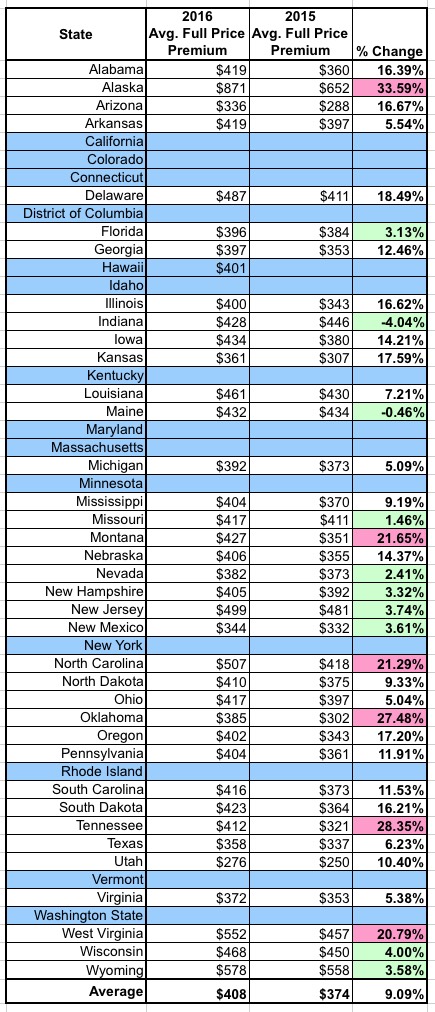BOOM: EFFECTIVE avg. 2016 ACA exchange rate hikes: ~9% nationally
According to the McKinsey Center report, the nationwide weighted average increase is 11.7%, slightly below my 12-13% estimate. Unlike the Avalere Health report, the McKinsey study appears to be more of a true apples-to-apples comparison:
- It includes all 50 states, plus DC.
- It includes all Silver plans, not just the lowest-priced one.
- It includes all Metal Levels as well as Catastrophic.
In fact, the only significant differences between the McKinsey Center report and mine are:
- My estimate includes off-exchange ACA-compliant policies as well as exchange-based ones
- My estimate attempted to look at the average change as opposed to the median change (the distinction of which, admittedly, is often difficult to remember)
Regardless, I think it's safe to say that my 12-13% estimate is on pretty damned safe ground.
Of course, even if I'm 100% on target, the biggest caveat here is that these numbers all still assume that everyone renews their existing policies instead of shopping around, which everyone should do. The lowest-cost plan within a given metal level won't make sense for everyone, but it will for many people, and if a significant number of people switched to a lower-cost policy it would indeed reduce the average rate changes significantly (I could see the effective average rate hike ending up around perhaps 9-10% nationally after the dust settles next spring).
*IMPORTANT: This assumes that everyone currently enrolled sticks with their current policy next year. If enough people shop around and consider their options, the average premiums for various plans, various companies, in vartious states and nationally could end up being considerably lower (possibly coming in under 10% overall).
Well, guess what? The Hill, Today:
The average ObamaCare premium rose to $408 per month for 2016 plans, about a 9 percent increase from this time last year, according to a new report from the Department of Health and Human Services.
However, 83 percent of ObamaCare enrollees pay far less than $408 because they get tax credits under the healthcare law. The average tax credit for 2016 is $294, meaning that the average share of the premiums that enrollees have to pay is $113. That is up $8 from the $105 people paid on average last year.
The size of the financial assistance from the government in turn increased as the overall premium level rose. The average tax credit increased from $268 to $294 per month.
As Republicans highlighted, premium increases for certain plans in some states were far higher, as much as 40 percent. But the report released Thursday shows that on average premium increases were less than that, and tax credits helped reduce the burden even more.
The average is more like 9.1%, actually ($408 vs. $374), but still.
Even better: As noted in the article, this report only includes the 38 states covered by HC.gov, and only covers enrollees thorugh 12/26/15, which means, assuming around 14 million QHP selections total by the end of Open Enrollment, that this report only analyzes around 60% of the national total (8.52 million). The overall average could move up or down a bit by the time the dust settles.
For instance, California's average rate hikes should only end up being around 4%. Since CA has enrolled nearly 1.5 million people, that would knock the overall average down to just 8.3% across around 71% of the total. Adding in the other dozen states, as well as the post-December enrollees, could move the needle up or down a few more tenths of a percent (my estimates for 8 of the remaining states (CO, CT, DC, MA, NY, RI, VT & WA) all average well below 10%, while the other 4 (ID, KY, MD & MN) came in at double digits.)
In other words, while rates on certain plans, from certain carriers, in certain regions of certain states did indeed go up substantially (ranging from small reductions in Indiana and Maine to a 33% average increase in Alaska), overall, the average increase nationally, even at full price is coming in under 10%.
...which means that in the end, the headline on my piece from last May was proven correct after all.




